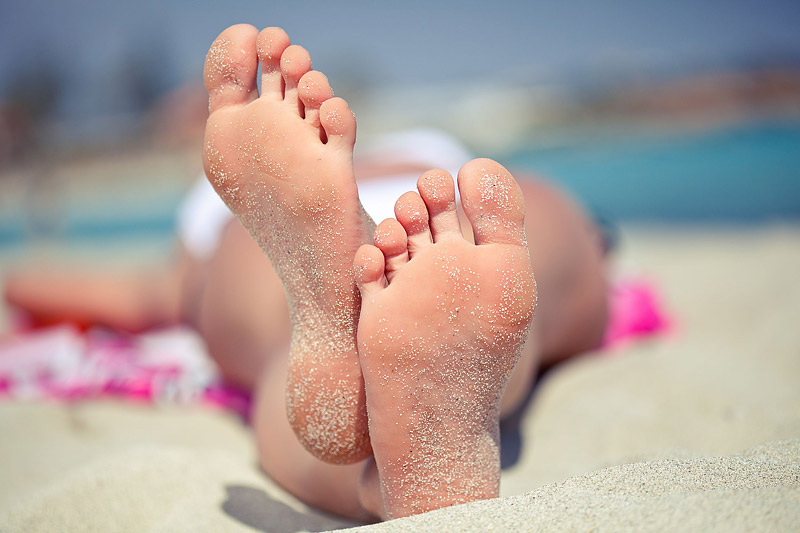
It’s no secret that the sun provides all sorts of health benefits, including helping our bodies manufacture vital vitamin D. With beach season right around the corner, though, many people are looking for the best sunscreens to cut their risk of sun overexposure, sunburns and possibly skin cancer.
The issue? All sunscreens are not created equally. In fact, a spring 2016 report from Environmental Working Group (EWG) found that 72 percent of sunscreens tested contain harmful ingredients or inadequate sun protection. This is EWG’s 10th annual Guide to Sunscreens report, and the results show that while there have been major improvements over the last decade, the vast majority of sunscreens available for purchase in the U.S. still contain toxic chemicals or fail to offer enough protection against ultraviolet rays.
It’s important to note that there is no perfect sunscreen. Many contain harmful chemicals, and even mineral-based ones often contain nanoparticles, minute ingredients that can cross the blood-brain barrier and also harm aquatic life. EWG rated 750 sunscreens, more than 500 SPF-labeled moisturizers and 100 lip products based on safety and how well they actually worked, helping consumers find (while not perfect) better options. So what are the best sunscreens out there? Let’s take a look.
The Best Sunscreens of 2016
Safer Sunscreens — Beach & Sport
- All Terrain AquaSport Sunscreen Lotion, SPF 30
- All Good Unscented Sunstick, SPF 30
- Babo Botanicals Clear Zinc Sunscreen Lotion, Fragrance Free, SPF 30
- Babyganics Pure Mineral Sunscreen Stick, SPF 50+
- Badger Sport Sunscreen Cream, Unscented, SPF 35
- Blue Lizard Australian Sunscreen, Sensitive, SPF 30+
- MDSolarSciences Mineral Creme Sunscreen, SPF 30
- Sunology Natural Sunscreen, Face, SPF 50
- Thinksport Sunscreen, SPF 50+
Safer Sunscreens — Moisturizers
- Andalou Naturals All in One Beauty Balm, Sheer Tint, SPF 30
- Badger Damascus Rose Face Sunscreen Lotion, SPF 25
- bareMinerals Prep Step Mineral Shield Daily Prep Lotion, SPF 50
- Block Island Organics Natural Face Moisturizer, SPF 30
- Keys Care KPRO Moisturizer with Sunscreen, SPF 30+
- Juice Beauty Mineral Moisturizer, Sheer, SPF 30
- Suntegrity Skincare 5 in 1 Natural Moisturizing Face Sunscreen, SPF 30
- Thinksport Every Day Face Sunscreen, SPF 30+
Safer Sunscreens — Kid-Friendly
- Adorable Baby Sunscreen Lotion, SPF 30+
- All Good Kid’s Sunscreen, SPF 33
- All Terrain KidSport Sunscreen Lotion, SPF 30
- ATTITUDE Little Ones 100% Mineral Sunscreen, Fragrance Free, SPF 30
- Badger Kids Sunscreen Cream, SPF 30
- Bare Belly Organics Baby Sunscreen, SPF 30
- Belly Buttons & Babies Sunscreen Lotion, SPF 30
- Blue Lizard Australian Sunscreen, Baby, SPF 30+
- BurnOut Kids Physical Sunscreen, SPF 35
- California Baby Super Sensitive Sunscreen, SPF 30+
- COOLA Suncare Baby Mineral Sunscreen Unscented Moisturizer, SPF 50
- Goddess Garden Kids Sport Natural Sunscreen Lotion, SPF 30
- Hampton Sun Sunscreen Lotion For Baby, SPF 45
- Jersey Kids Mineral Sunscreen Lotion, SPF 30
- Kiss My Face Organics Kids Mineral Sunscreen, SPF 30
- Nurture My Body Baby Organic Sunscreen, SPF 32
- Sunology Natural Sunscreen, Kids, SPF 50
Toxic Sunscreens to Avoid

EWG focused even more closely on children’s sunscreens this year, in part because children are more susceptible to certain toxic chemicals during development and because blistering sunburns early in life can lead to an increased risk of skin cancer down the line. While other brands received low scores, EWG specifically called out the following brands because they earned the worst scores.
Worst Sunscreens for Kids
- Banana Boat Kids Max Protect & Play Sunscreen Lotion, SPF 100
- Coppertone Water Babies Sunscreen Stick, SPF 55
- Coppertone Sunscreen Continuous Spray, Kids, SPF 70
- Coppertone Sunscreen Lotion Kids, SPF 70+
- Coppertone Foaming Lotion Sunscreen Kids Wacky Foam, SPF 70+
- Coppertone Water Babies Sunscreen Lotion, SPF 70+
- CVS Baby Sunstick Sunscreen, SPF 55
- CVS Kids Wet & Dry Sunscreen Spray, SPF 70+
- Equate Kids Sunscreen Stick, SPF 55
- Hampton Sun Continuous Mist Sunscreen For Kids, SPF 70 
- Neutrogena Wet Skin Kids Sunscreen Spray, SPF 70+
- Neutrogena Wet Skin Kids Sunscreen Stick, SPF 70+
- Up & Up Kids Sunscreen Stick, SPF 55
Key Findings in EWG’s Sunscreen Report
- About half the sunscreen products sold in the U.S. wouldn’t pass the more stringent European standards because they don’t filter enough UVA rays.
- 16 percent of beach and sport sunscreens, 14 percent of moisturizers with SPF, and 10 percent of lip products contained retinyl palmitate, an anti-aging antioxidant that may trigger skin tumors and lesions when sunlight hits it.
- Nearly 30 percent of sunscreens tested were sprays, up from 20 percent in 2007. These sprays pose inhalation risk and are hard to actually apply correctly. (Even the Food and Drug Administration raised concerns about spray sunscreens, although the agency hasn’t banned them yet.)
- 70 percent of non-mineral sunscreens contained the allergen and hormone-disrupting chemical oxybenzone.
- If you avoid the sun, get your vitamin D levels checked at your health care provider. A growing number of the population is deficient, thanks to sunscreens and spending more time indoors.
How to Avoid Too Much Sun (Without Sunscreen)
Getting some sun exposure is vital for good health because it helps your body create vitamin D. You can get vitamin D through supplements or vitamin D-rich foods, but direct sunlight is your best option. In fact, sitting in the sun unexposed for about 10 minutes helps your body create roughly 10,000 units of natural vitamin D.
Vitamin D deficiency has been linked to certain cancers, autoimmune diseases, heart disease depression, osteoporosis and many other ailments, so it’s important to get enough. Like almost anything, though, you can get too much of a good thing and want to make sure you avoid sunburns.
You should consider sunscreen your last resort to prevent sunburns, though. In fact, there’s no clear evidence that using sunscreens actually prevents skin cancer — including in the best sunscreens — and some ingredients may actually fuel skin cancer. Avoiding overexposure during peak sunlight hours, use sunglasses, and sun-protective hats and clothing reduce your risk of burns without sunscreen.
Final Thoughts on the Best Sunscreens
When direct sunlight hits our skin under peak conditions, our bodies manufacture high levels of vitamin D. Not getting enough vitamin D has been linked to all sorts of health problems, include cancer, arthritis, depression and other diseases. However, you can get too much of a good thing, which is why it’s important to take steps to prevent overexposure and sunburns.
There is no perfect sunscreen, and this is clear from EWG’s 10th Guide to Sunscreens report. Mineral sunscreens generally rate safer, but they often contain nanoparticles that are not tightly regulated or studied for long-term impact on human or aquatic health. Chemical sunscreens often contain hormone-disrupting chemicals or even an ingredient that could trigger skin cancer. Still, EWG’s report helps consumers seeking sunscreen find safer choices while avoiding the most poorly rated brands.
Sunscreen should be used as a last resort. Sun-protective measures like hats, sunglasses, seeking shade and avoiding peak sunlight for extended periods of time should be used before turning to sunscreen, and when you do choose sunscreen, make sure it’s one of the best sunscreens.




Leave a Reply